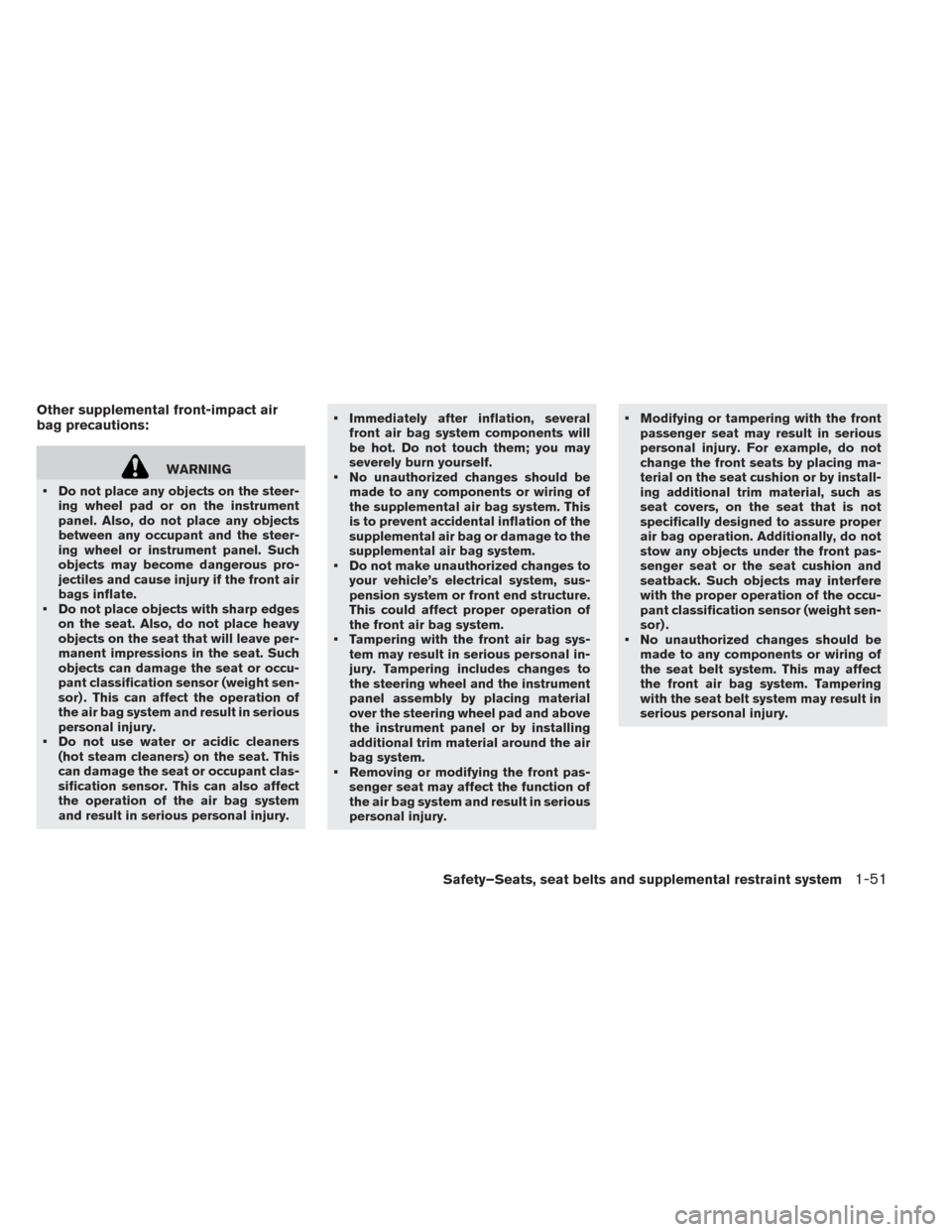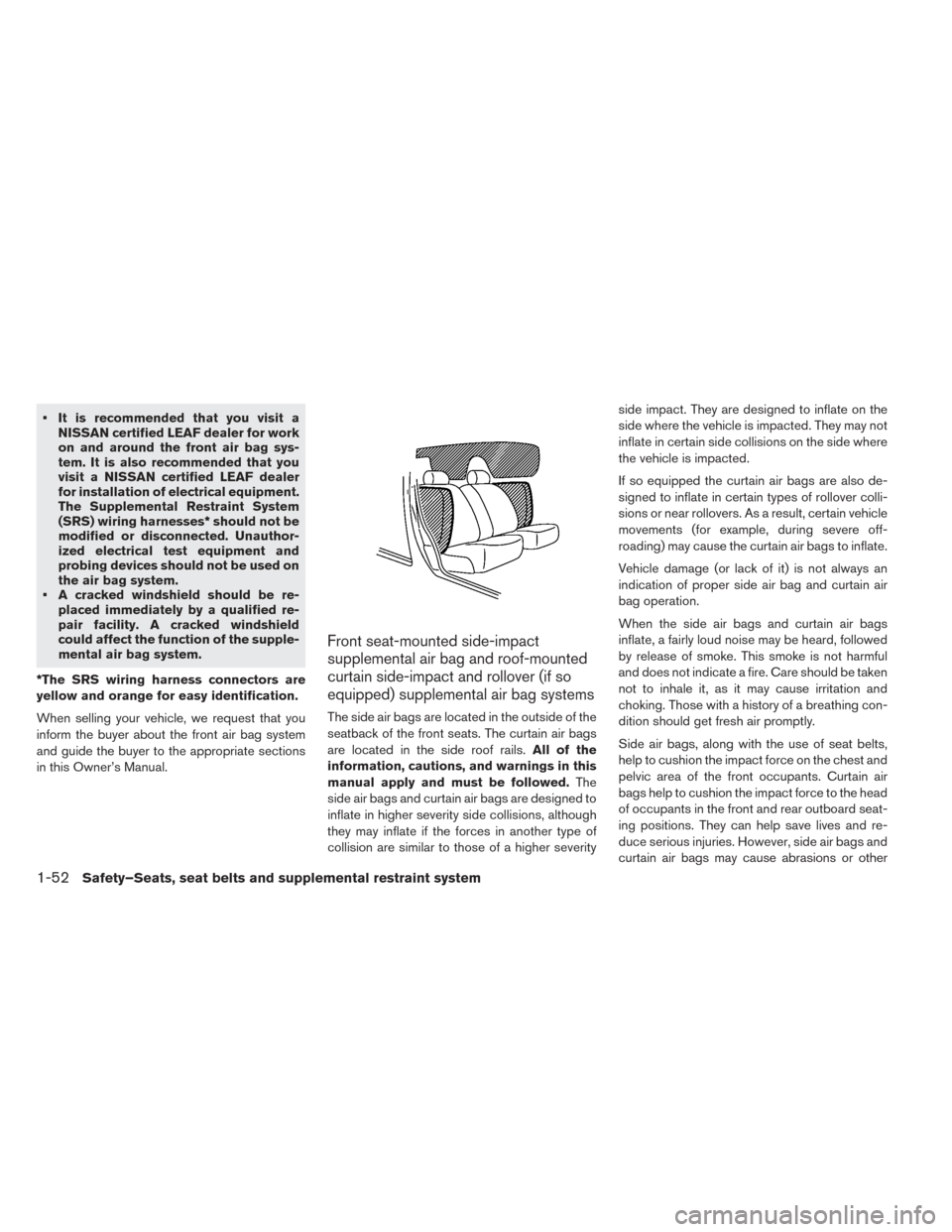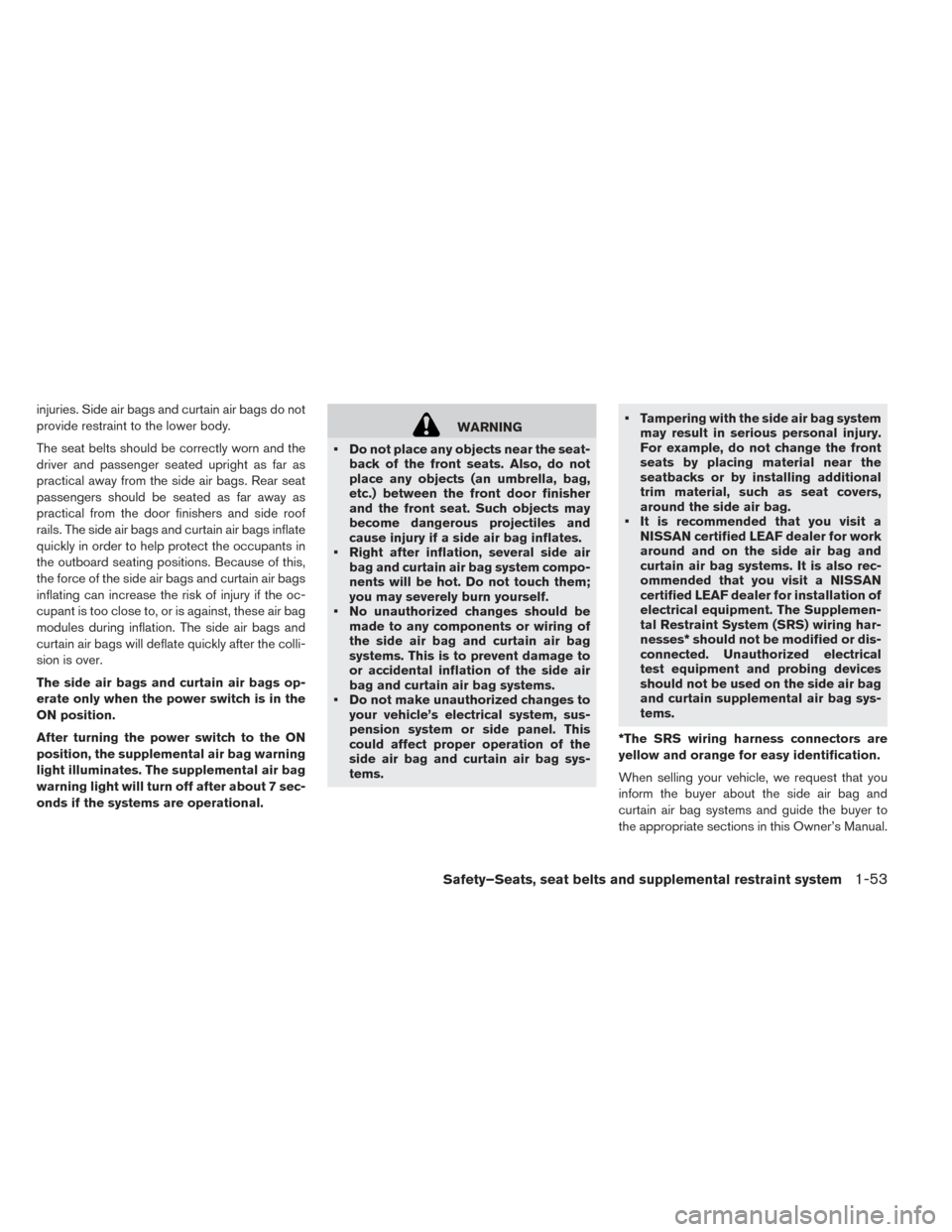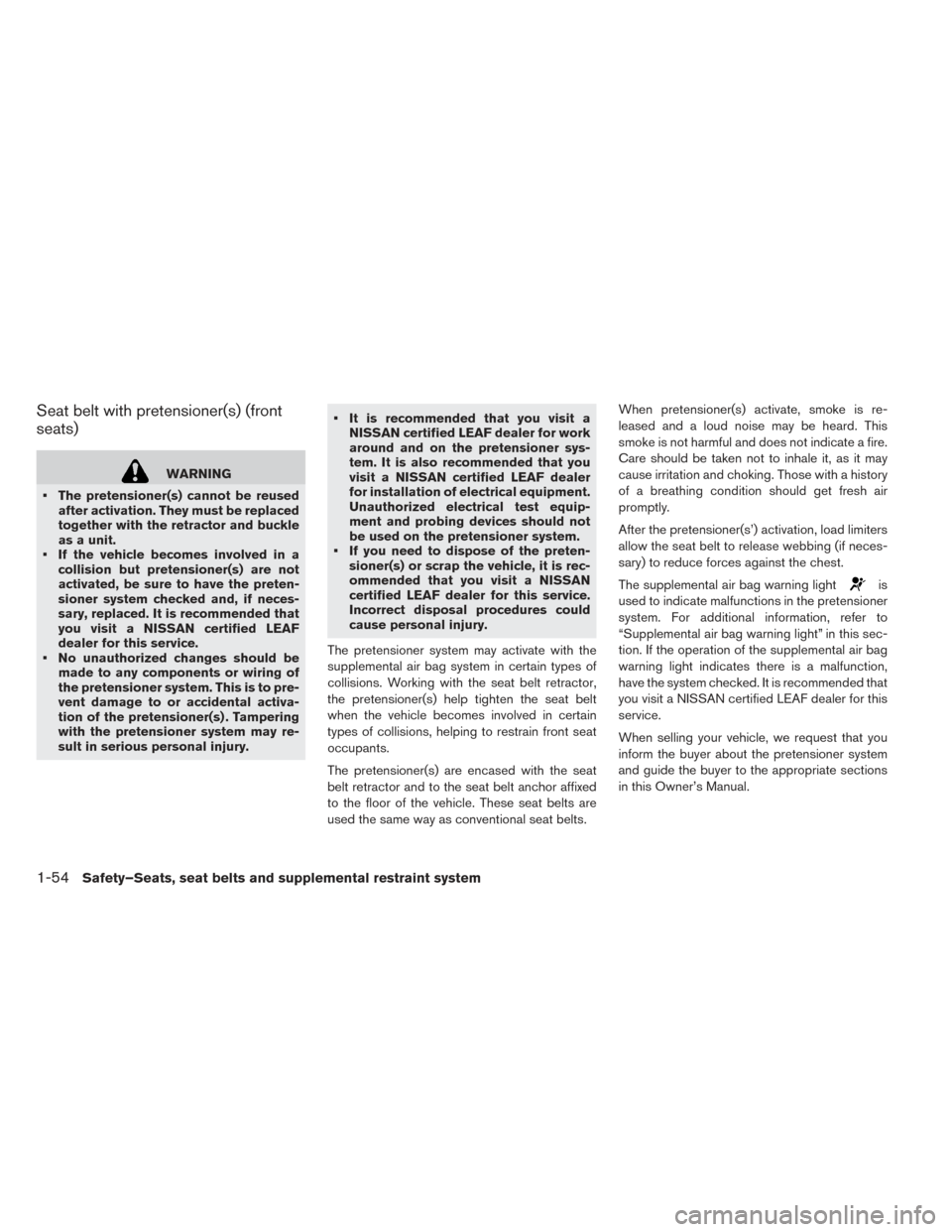2017 NISSAN LEAF wiring
[x] Cancel search: wiringPage 27 of 424

WARNING
In case of a collision:
• If your vehicle is drivable, pull your vehicle off the road, push the P (Park)
position switch on the shift lever, apply
the parking brake and turn the EV sys-
tem off.
• Check your vehicle to see if there are exposed high-voltage parts or cables.
For their locations, refer to “High volt-
age components” in this section. To
avoid personal injury, never touch
high-voltage wiring, connectors, and
other high-voltage parts, such as in-
verter unit and Li-ion battery. An elec-
tric shock may occur if exposed electric
wires are visible when viewed from
inside or outside of your vehicle.
Therefore, never touch exposed elec-
tric wires.
• If the vehicle receives a strong impact to the floor while driving, stop the ve-
hicle in a safe location and check the
floor. • Leaks or damage to the Li-ion battery
may result in a fire. If you discover
them, contact emergency services im-
mediately. Since the fluid leak may be
lithium manganate from the Li-ion bat-
tery, never touch the fluid leak inside
or outside the vehicle. If the fluid con-
tacts your skin or eyes, wash it off
immediately with a large amount of
water and receive immediate medical
attention to help avoid serious injury.
• If a fire occurs in the EV, leave the vehicle as soon as possible. Only use a
type ABC, BC or C fire extinguisher
that is meant for use on electrical fires.
Using a small amount of water or the
incorrect fire extinguisher can result in
serious injury or death from electrical
shock.
• If your vehicle needs to be towed, do it with the front wheels raised. If the
front wheels are on the ground when
towing, the traction motor may gener-
ate electricity. This may damage the
components of the EV system and
cause a fire. • If you are not able to safely assess the
vehicle due to vehicle damage, do not
touch the vehicle. Leave the vehicle
and contact emergency services. Ad-
vise first responders that this is an
electric vehicle.
• In the event of an accident that re- quires body repair and painting, the
Li-ion battery pack and high voltage
parts such as the inverter, including
the wire harness, should be removed
prior to painting. It is recommended
that you visit a NISSAN certified LEAF
dealer for this service. Li-ion battery
packs exposed to heat in the paint
booth will experience capacity loss.
Damaged Li-ion battery packs may
also pose safety risks to untrained me-
chanics and repair personnel.
ROAD ACCIDENT PRECAUTIONS
EV-8EV Overview
Page 134 of 424

Other supplemental front-impact air
bag precautions:
WARNING
• Do not place any objects on the steer- ing wheel pad or on the instrument
panel. Also, do not place any objects
between any occupant and the steer-
ing wheel or instrument panel. Such
objects may become dangerous pro-
jectiles and cause injury if the front air
bags inflate.
• Do not place objects with sharp edges on the seat. Also, do not place heavy
objects on the seat that will leave per-
manent impressions in the seat. Such
objects can damage the seat or occu-
pant classification sensor (weight sen-
sor) . This can affect the operation of
the air bag system and result in serious
personal injury.
• Do not use water or acidic cleaners (hot steam cleaners) on the seat. This
can damage the seat or occupant clas-
sification sensor. This can also affect
the operation of the air bag system
and result in serious personal injury. • Immediately after inflation, several
front air bag system components will
be hot. Do not touch them; you may
severely burn yourself.
• No unauthorized changes should be made to any components or wiring of
the supplemental air bag system. This
is to prevent accidental inflation of the
supplemental air bag or damage to the
supplemental air bag system.
• Do not make unauthorized changes to your vehicle’s electrical system, sus-
pension system or front end structure.
This could affect proper operation of
the front air bag system.
• Tampering with the front air bag sys- tem may result in serious personal in-
jury. Tampering includes changes to
the steering wheel and the instrument
panel assembly by placing material
over the steering wheel pad and above
the instrument panel or by installing
additional trim material around the air
bag system.
• Removing or modifying the front pas- senger seat may affect the function of
the air bag system and result in serious
personal injury. • Modifying or tampering with the front
passenger seat may result in serious
personal injury. For example, do not
change the front seats by placing ma-
terial on the seat cushion or by install-
ing additional trim material, such as
seat covers, on the seat that is not
specifically designed to assure proper
air bag operation. Additionally, do not
stow any objects under the front pas-
senger seat or the seat cushion and
seatback. Such objects may interfere
with the proper operation of the occu-
pant classification sensor (weight sen-
sor) .
• No unauthorized changes should be made to any components or wiring of
the seat belt system. This may affect
the front air bag system. Tampering
with the seat belt system may result in
serious personal injury.
Safety–Seats, seat belts and supplemental restraint system1-51
Page 135 of 424

• It is recommended that you visit aNISSAN certified LEAF dealer for work
on and around the front air bag sys-
tem. It is also recommended that you
visit a NISSAN certified LEAF dealer
for installation of electrical equipment.
The Supplemental Restraint System
(SRS) wiring harnesses* should not be
modified or disconnected. Unauthor-
ized electrical test equipment and
probing devices should not be used on
the air bag system.
• A cracked windshield should be re- placed immediately by a qualified re-
pair facility. A cracked windshield
could affect the function of the supple-
mental air bag system.
*The SRS wiring harness connectors are
yellow and orange for easy identification.
When selling your vehicle, we request that you
inform the buyer about the front air bag system
and guide the buyer to the appropriate sections
in this Owner’s Manual.
Front seat-mounted side-impact
supplemental air bag and roof-mounted
curtain side-impact and rollover (if so
equipped) supplemental air bag systems
The side air bags are located in the outside of the
seatback of the front seats. The curtain air bags
are located in the side roof rails. All of the
information, cautions, and warnings in this
manual apply and must be followed. The
side air bags and curtain air bags are designed to
inflate in higher severity side collisions, although
they may inflate if the forces in another type of
collision are similar to those of a higher severity side impact. They are designed to inflate on the
side where the vehicle is impacted. They may not
inflate in certain side collisions on the side where
the vehicle is impacted.
If so equipped the curtain air bags are also de-
signed to inflate in certain types of rollover colli-
sions or near rollovers. As a result, certain vehicle
movements (for example, during severe off-
roading) may cause the curtain air bags to inflate.
Vehicle damage (or lack of it) is not always an
indication of proper side air bag and curtain air
bag operation.
When the side air bags and curtain air bags
inflate, a fairly loud noise may be heard, followed
by release of smoke. This smoke is not harmful
and does not indicate a fire. Care should be taken
not to inhale it, as it may cause irritation and
choking. Those with a history of a breathing con-
dition should get fresh air promptly.
Side air bags, along with the use of seat belts,
help to cushion the impact force on the chest and
pelvic area of the front occupants. Curtain air
bags help to cushion the impact force to the head
of occupants in the front and rear outboard seat-
ing positions. They can help save lives and re-
duce serious injuries. However, side air bags and
curtain air bags may cause abrasions or other
1-52Safety–Seats, seat belts and supplemental restraint system
Page 136 of 424

injuries. Side air bags and curtain air bags do not
provide restraint to the lower body.
The seat belts should be correctly worn and the
driver and passenger seated upright as far as
practical away from the side air bags. Rear seat
passengers should be seated as far away as
practical from the door finishers and side roof
rails. The side air bags and curtain air bags inflate
quickly in order to help protect the occupants in
the outboard seating positions. Because of this,
the force of the side air bags and curtain air bags
inflating can increase the risk of injury if the oc-
cupant is too close to, or is against, these air bag
modules during inflation. The side air bags and
curtain air bags will deflate quickly after the colli-
sion is over.
The side air bags and curtain air bags op-
erate only when the power switch is in the
ON position.
After turning the power switch to the ON
position, the supplemental air bag warning
light illuminates. The supplemental air bag
warning light will turn off after about 7 sec-
onds if the systems are operational.
WARNING
• Do not place any objects near the seat- back of the front seats. Also, do not
place any objects (an umbrella, bag,
etc.) between the front door finisher
and the front seat. Such objects may
become dangerous projectiles and
cause injury if a side air bag inflates.
• Right after inflation, several side air bag and curtain air bag system compo-
nents will be hot. Do not touch them;
you may severely burn yourself.
• No unauthorized changes should be made to any components or wiring of
the side air bag and curtain air bag
systems. This is to prevent damage to
or accidental inflation of the side air
bag and curtain air bag systems.
• Do not make unauthorized changes to your vehicle’s electrical system, sus-
pension system or side panel. This
could affect proper operation of the
side air bag and curtain air bag sys-
tems. • Tampering with the side air bag system
may result in serious personal injury.
For example, do not change the front
seats by placing material near the
seatbacks or by installing additional
trim material, such as seat covers,
around the side air bag.
• It is recommended that you visit a NISSAN certified LEAF dealer for work
around and on the side air bag and
curtain air bag systems. It is also rec-
ommended that you visit a NISSAN
certified LEAF dealer for installation of
electrical equipment. The Supplemen-
tal Restraint System (SRS) wiring har-
nesses* should not be modified or dis-
connected. Unauthorized electrical
test equipment and probing devices
should not be used on the side air bag
and curtain supplemental air bag sys-
tems.
*The SRS wiring harness connectors are
yellow and orange for easy identification.
When selling your vehicle, we request that you
inform the buyer about the side air bag and
curtain air bag systems and guide the buyer to
the appropriate sections in this Owner’s Manual.
Safety–Seats, seat belts and supplemental restraint system1-53
Page 137 of 424

Seat belt with pretensioner(s) (front
seats)
WARNING
• The pretensioner(s) cannot be reused after activation. They must be replaced
together with the retractor and buckle
as a unit.
• If the vehicle becomes involved in a collision but pretensioner(s) are not
activated, be sure to have the preten-
sioner system checked and, if neces-
sary, replaced. It is recommended that
you visit a NISSAN certified LEAF
dealer for this service.
• No unauthorized changes should be made to any components or wiring of
the pretensioner system. This is to pre-
vent damage to or accidental activa-
tion of the pretensioner(s) . Tampering
with the pretensioner system may re-
sult in serious personal injury. • It is recommended that you visit a
NISSAN certified LEAF dealer for work
around and on the pretensioner sys-
tem. It is also recommended that you
visit a NISSAN certified LEAF dealer
for installation of electrical equipment.
Unauthorized electrical test equip-
ment and probing devices should not
be used on the pretensioner system.
• If you need to dispose of the preten- sioner(s) or scrap the vehicle, it is rec-
ommended that you visit a NISSAN
certified LEAF dealer for this service.
Incorrect disposal procedures could
cause personal injury.
The pretensioner system may activate with the
supplemental air bag system in certain types of
collisions. Working with the seat belt retractor,
the pretensioner(s) help tighten the seat belt
when the vehicle becomes involved in certain
types of collisions, helping to restrain front seat
occupants.
The pretensioner(s) are encased with the seat
belt retractor and to the seat belt anchor affixed
to the floor of the vehicle. These seat belts are
used the same way as conventional seat belts. When pretensioner(s) activate, smoke is re-
leased and a loud noise may be heard. This
smoke is not harmful and does not indicate a fire.
Care should be taken not to inhale it, as it may
cause irritation and choking. Those with a history
of a breathing condition should get fresh air
promptly.
After the pretensioner(s’) activation, load limiters
allow the seat belt to release webbing (if neces-
sary) to reduce forces against the chest.
The supplemental air bag warning light
is
used to indicate malfunctions in the pretensioner
system. For additional information, refer to
“Supplemental air bag warning light” in this sec-
tion. If the operation of the supplemental air bag
warning light indicates there is a malfunction,
have the system checked. It is recommended that
you visit a NISSAN certified LEAF dealer for this
service.
When selling your vehicle, we request that you
inform the buyer about the pretensioner system
and guide the buyer to the appropriate sections
in this Owner’s Manual.
1-54Safety–Seats, seat belts and supplemental restraint system
Page 138 of 424

SUPPLEMENTAL AIR BAG
WARNING LABELS
A. Supplemental front-impact air bag system
warning labels
The warning labels are located on the surface of
the sun visors.
SUPPLEMENTAL AIR BAG
WARNING LIGHT
The supplemental air bag warning light, display-
ing
in the instrument panel, monitors the
circuits of the Air bag Control Unit (ACU) , satel-
lite sensors, crash zone sensor, occupant classi-
fication sensor, the supplemental front-impact air
bag, front seat-mounted side-impact supple-
mental air bag, roof-mounted curtain side-impact
supplemental air bag and seat belt pretensioner
systems. The monitored circuits include air bag
systems, pretensioner(s) and all related wiring. When the power switch is in the ON position, the
supplemental air bag warning light illuminates for
about 7 seconds and then turns off. This means
the system is operational.
If any of the following conditions occur, the front
air bag, side air bag, curtain air bag and preten-
sioner systems need servicing:
• The supplemental air bag warning light remains
on after approximately 7 seconds.
• The supplemental air bag warning light flashes intermittently.
• The supplemental air bag warning light does not come on at all.
Under these conditions, the front air bag, side air
bag, curtain air bag and pretensioner systems
may not operate properly. They must be checked
and repaired. It is recommended that you visit the
nearest NISSAN certified LEAF dealer for this
service.
Safety–Seats, seat belts and supplemental restraint system1-55
Page 397 of 424

CHARGING SYSTEM
Rated input voltageAC120V (single phase) , AC240V (single phase)
Rated input frequency 60Hz
Maximum rated current 12A AC120V, 18A (AC240V) , 32A (AC220V; if so equipped)
Charging modes/Types of connection AC Level 2 (Normal charge with home installation type EVSE (Electric Vehicle Supply Equipment))
DC Charging (Quick charge)
Required installation (over current protection) The methods of protection against over current and over voltage shall be in accordance with national codes.
Suitable over current protection devices for the wiring of houses or buildings shall be installed.
IP Degree IP55: EV (Electric Vehicle) charging port in road position
Operating temperature Same as vehicle operating temperature
Storage temperature Same as vehicle storage temperature
Rated input voltage
Rate input frequency AC220V (single phase) , AC240V (single
phase)
60Hz
Applicable standards SAE J1772: 2010
EN61851-1: 2011
EN61851-21: 2002
IEC61851-1: 2010
IEC61851-21: 2001EN61000-6-1: 2007
EN61000-6-3: 2007
Adapters Do not use an extension cable or electrical adaptor.
SPECIFICATIONS
9-4Technical and consumer information